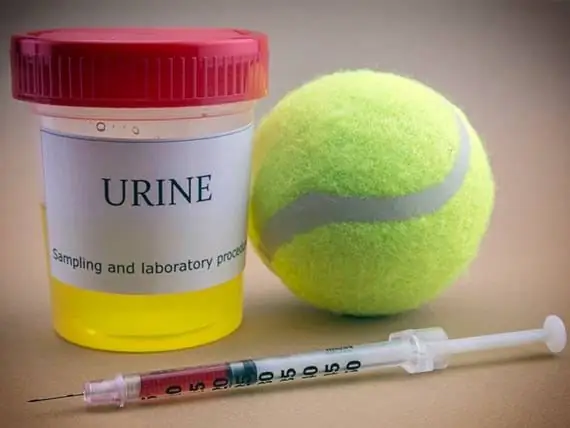
- Pengarang Daisy Haig [email protected].
- Public 2023-12-17 03:12.
- Diubah suai terakhir 2025-06-01 06:47.
Jadi, apa ujian caca yang memalukan itu?
Cukup tertekan apabila bahagian belakang haiwan peliharaan anda dilanggar oleh batang plastik, bukan? Jadi apa gunanya?
Anda mengatakan: Sekiranya tujuannya adalah untuk menjadikan haiwan kesayangan saya lebih sihat dan bebas parasit maka saya akan mempercayai penilaian anda, tetapi saya harus katakan, pemeriksaan najis adalah sejenis hukuman yang kejam dan luar biasa. Saya tidak mendapat penghinaan seperti itu sehingga saya berumur empat puluh tahun, bukan? Dan najis tidak begitu membantu, bukan?
Saya katakan: Sebagai permulaan, anda tidak perlu membawa haiwan kesayangan anda ke batang yang berbahaya. Sampel segar biasanya diperoleh dengan mudah pagi (atau petang) sebelum lawatan tahunan anda atau bila-bila masa haiwan kesayangan anda mengalami gejala gastrousus. Ia tidak begitu sukar, Dan jika waktunya tidak tepat (najis tidak boleh lebih dari satu jam untuk hasil terbaik), hospital doktor haiwan anda pasti tidak akan menolak anda hak untuk membawa sampel yang sangat segar mengikut keselesaan anda. Janji.
Dan ya, pemeriksaan tinja, walaupun agak murah dan rutin, sangat diperlukan. Tetapi seperti yang ditunjukkan oleh siaran ini, juga benar bahawa tidak semua ujian tinja akan menyebabkan jangkitan parasit pada haiwan kesayangan anda. Itulah sebabnya pemeriksaan tahunan dan / atau tahi bersiri mungkin diperlukan.
Sekarang untuk tujuan utama ujian:
Doktor haiwan selalu mencari parasit yang mungkin masuk ke saluran gastrointestinal haiwan kesayangan anda. Sudah tentu, kita juga boleh mendapat parasit, tetapi gaya hidup moden kita cenderung kurang kondusif untuk jangkitan parasit. (Kapan terakhir kali Anda meringkuk di halaman, bibir ke tanah, supaya anda dapat menyedut kotoran kucing atau dua?)
Ya, haiwan peliharaan mendapat banyak parasit. Berikut adalah contoh parasit gastrointestinal yang paling biasa yang saya lihat di sini [di syurga parasit yang merupakan semi-tropis Florida Selatan]:
Cacing bulat pada anjing dan kucing.
Cacing cacing dalam haiwan peliharaan
Cacing cambuk dalam haiwan peliharaan
Giardia dalam haiwan kesayangan

Gangguan hati pada haiwan peliharaan
Gangguan hati pada haiwan peliharaan
coccidia in pets
i’ll not go into the gory details on each but you can click on the links and check out the info for a better understanding of how these parasites can potentially affect your pets and even your human family.
sure, pet-popular parasites don’t often infect humans in the so-called, “developed” nations all of you reading this likely live in, but that doesn’t mean it doesn’t happen. roundworms and hookworms are still a factor in humans in the us, as is giardia, which will give you the nastiest case of diarrhea you can imagine short of amoebic dysentery.
since veterinarians are also on the front lines when it comes to public health, consider that fecal exams are not just necessary for healthy pets, they’re essential for healthy humans, too, more so if your family members are very young children, very old adults or otherwise immunocompromised (transplant patients, hiv-positive humans, chemo recipients, etc.).
how do we identify these critters in the fecal exam?
the short answer: with a microscope.
the long answer: we take a tiny sample of your pet’s stool (very fresh is always best). a few grams is enough (think an eighth of a teaspoon if that’s easier). then we put it through one of three processes.
1. the smear: we take about a half gram of stool and smear it onto a microscope slide to search for parasites (and bacteria) directly. many times we’ll see them swimming about. finding evidence of parasites in a simple smear is often indicative of severe infection.
2. the float: this method relies on mixing the stool with a special solution. it filters out the big pieces of stool in a tube or other cylindrical vessel and allows the eggs and other small critters to float up to the top, buoyed by the solution’s specific gravity. a microscope slide’s cover slip is typically used to recover the floaters. some parasites, however, aren’t amenable to flotation. eggs seem to do best through this method.
3. centrifugation: spinning the heck out of stool in a centrifuge when it’s mixed in a sugar solution picks up about 50% more parasite eggs and oocysts than through flotation. therefore, i like this method best for worm eggs, giardia, and coccidia--though i’d never go without a smear. problem is, most hospitals don’t yet use this method. it’s more expensive than others and research demonstrating it’s much greater efficacy is fairly recent.
so now you know the truth: not all fecal exams are created equal. not only does this test rely on careful selection of materials and methods, it also requires a trained eye. in our practice, for example, one of our techs detects parasites about 50% more often than the veterinarians and other techs/assistants. (that’s why we also do floats so that she can check them all at her convenience when she comes back from her day off.)
it’s also true that even a parasite-infected animal will often not come up positive on a fecal test. human error and equipment choice are factors, but so is the parasite itself. sometimes they do not make themselves known in the stool. worms sometimes aren’t shedding their eggs and subclinical (low-grade or smoldering) infections may not reveal much, either.
again, that’s why it’s important to perform this test as often as is reasonable. for all dogs and cats at least three times during the first few months of life. i want to see at least two negative tests in a row, a month apart, before i’ll feel comfortable that my patient is parasite-free.
for adults, once a year is great--that is, unless they show gastrointestinal illnesses. in this case, serial fecal tests make sense--or at least one every time the symptoms recur until a definitive diagnosis is made (whether it’s parasites or something else).
ultimately, fecal tests are a critical component of our veterinary hat of tricks. doing without may seem like the economically wisest thing in the absence of gastrointestinal symptoms, but consider: parasites can wear pets down in ways you might not expect. and it’s never wrong to be too safe in the presence of diseases that may also affect your family. ‘nuff said.
Disyorkan:
Apa Itu Ujian Titer, Dan Apakah Itu Tepat Untuk Haiwan Peliharaan Anda?

Untuk mengatasi keprihatinan masyarakat yang semakin meningkat dan mengatasi bukti bahawa beberapa vaksin boleh memberi kesan buruk pada beberapa haiwan peliharaan, salah satu prosedur perubatan yang digunakan untuk menentukan perlunya vaksinasi adalah ujian titer. Ketahui lebih lanjut di sini
Kepentingan Berperanan Untuk Haiwan Peliharaan Dengan Kanser, Bahagian 3 - Ujian Urin Dan Fecal Untuk Haiwan Peliharaan Dengan Kanser

Sebahagian dari proses pementasan kanser untuk haiwan peliharaan dalam rawatan adalah menguji semua cairan tubuh yang berbeza. Dalam ansuran ini, Dr. Mahaney menerangkan proses ujian air kencing dan tinja. Baca lebih lanjut
Mengapa Haiwan Kesayangan Anda Memerlukan Ujian Rektum: Izinkan Saya Menghitung Caranya

"Hanya ada dua alasan untuk tidak melakukan ujian rektum: tidak ada rektum dan tidak ada jari." Demikian kata sumber (yang tidak akan disebutkan namanya) bulan lalu di rangkaian Jaringan Maklumat Veterinar yang meriah mengenai topik pemeriksaan rektum digital dalam perubatan haiwan kecil
Tidak Ada Haiwan Kesayangan Yang Tertinggal: Cara Memastikan Chip Mikro Membawa Haiwan Kesayangan Kami Pulang

Industri mikrocip haiwan peliharaan mendapat dorongan dari haiwan kesayangan yang memiliki minat orang ramai untuk menjaga haiwan kesayangan mereka dekat. Walaupun begitu, menurut pendapat doktor haiwan ini bahawa industri - dan produk itu sendiri - - menderita kesakitan yang semakin meningkat ketika permintaan pasaran haiwan peliharaan semakin matang melebihi apa yang dapat dibekalkan oleh mikrocip rendah semasa
Adakah Haiwan Kesayangan Saya Gay? Doktor Haiwan Ini Mengambil Pertanyaan Tentang Haiwan Kesayangan Gay (terhadap Penilaiannya Yang Lebih Baik)

"Saya harap saya dapat berhenti dari biri-biri" dan "Dia tidak suka dengan domba" tetapi dua dari rasa tidak sedap untuk menjadi tajuk utama setelah seorang penyelidik di Oregon State University mendapat beberapa akhbar PETA yang tidak diingini
